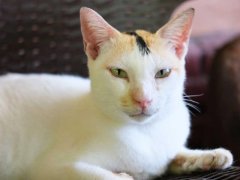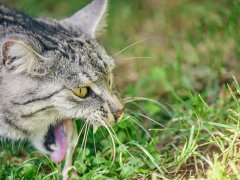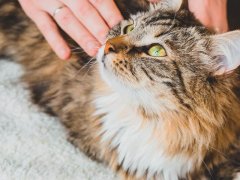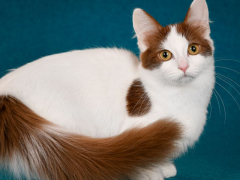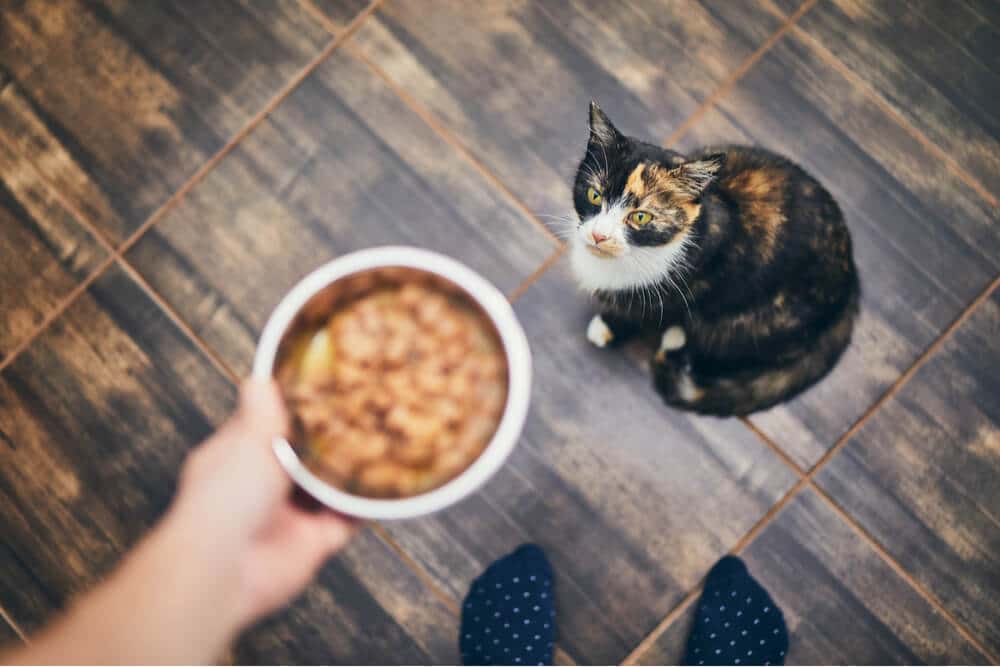
Despite our best efforts caring for our cat, purchasing expensive food, and giving them a safe, happy, and fulfilled life, our cat may temporarily stop eating.
Loss of appetite is a major concern for a cat parent, but when do you start worrying and ask for help?
In this article, we discuss why a cat may seem picky, what to do if your cat refuses to eat, and when to obtain professional veterinary advice.
Reasons Why Cats Refuse to Eat or Loss Their Appetite
There are several causes for inappetence. Certain signs are subtle. Others require a thorough behavioural assessment. Some cases require a medical diagnosis and treatment.
If your cat has stopped eating altogether, consider it an emergency situation and contact your veterinarian immediately. A veterinarian can help to identify and address the underlying cause of your cat’s inappetence and prevent the complications of inadequate food intake. Going without food for 72 hours or more could lead to hepatic lipidosis, a serious and potentially-fatal condition.
Here are a few common reasons why a cat may stop eating:
1. Medical Conditions
If you have trouble getting your cat to eat, consult your vet first to ensure no underlying disease is causing a weakened appetite.
A wide range of medical conditions can cause inappetence and anorexia. These include, but are not limited to:
- Digestive disease
- Respiratory disorders
- Dental issues
- Thyroid conditions
- Liver conditions
- Pancreatitis
- Feline chronic kidney disease (CKD)
- Diabetes mellitus
- Congestive heart failure
- Cancer
If your cat’s inappetence is caused by a health issue, it will likely be accompanied by other common symptoms of illness, including:
- Lethargy
- Weight loss
- Drooling
- Face swelling
- Increase in water intake
- Dehydration
- Vomiting or regurgitation
- Pawing at the face
- Reduced mobility
- Decreased activity
- Altered grooming
- Changes in normal temperament
A change in appetite is never something to ignore and always demands close monitoring. If the appetite change is accompanied by any of the symptoms above, you should take your cat to a veterinarian.
2. Anorexia
Anorexia is most common in hospitalised patients complicating their health problems by feeding refusal. Anorexia or loss of appetite may occur secondary to many underlying health problems in feline patients. The primary goal is to diagnose and treat the underlying disease.
Anorexic cats utilise muscle coupled with other proteins in addition to fat to maintain energy requirements.
3. Unsuitable Diets
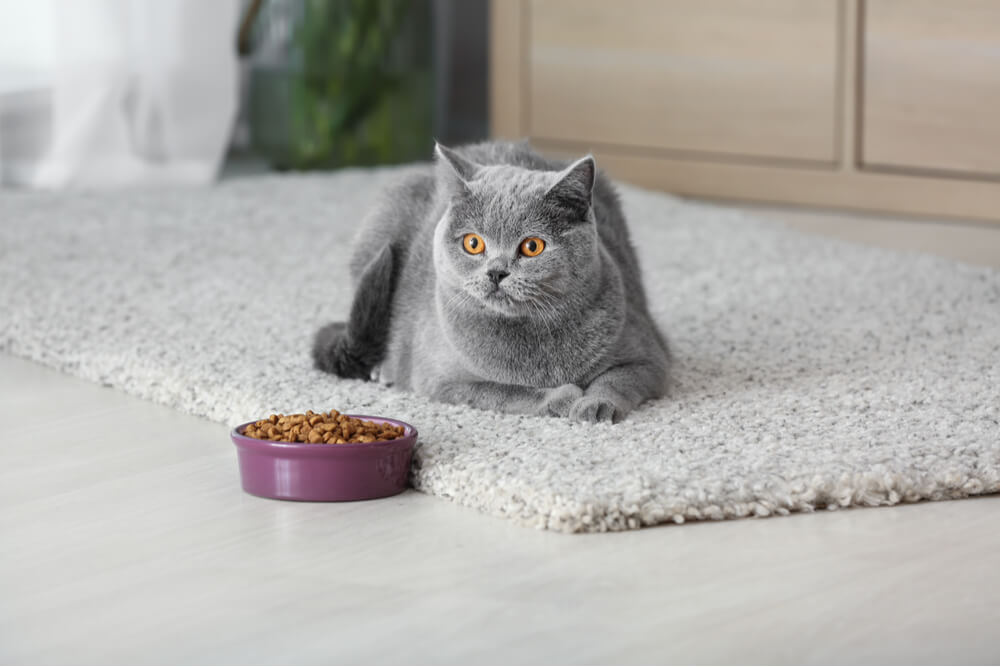
While inappetence is more often caused by health issues, cats may simply refuse to eat foods that are nutritionally inadequate or inappropriate.
Cats are obligate carnivores who must be fed a meat diet. They lack the ability to survive on a vegetarian diet. Giving your cat the wrong diet can affect digestion and cause poor appetite.
Cats and dogs have unique nutritional requirements; cats should not be fed dog food. The occasional venture into each other’s food bowls will not be harmful, but it should not be encouraged. Long-term feeding dog food to a cat can be dangerous as dog food is nutritionally incomplete for cats.
4. Feeding Adjustments
Swift changes in diet or feeding method can cause GI upsets or food refusal for some cats. Instead of making sudden changes in your cat’s diet, transition to new foods gradually over a couple of weeks.
5. Hunting Behaviour
When hunting, cats will seek small prey such as birds, insects, plus mice. They will stop eating commercial food and go off hunting if distracted by potential prey.
6. Neophilia or Neophobia
Cats can show aversions to both too much and too little variety in their diet.
Cats display strong neophilic (novelty) behaviour. Studies of feeding behaviour have demonstrated neophilia, in which cats may develop a growing aversion towards foods that have formed a large part of their diet, preferring experience new or unusual foods.
The majority of cats prefer to consume a variety of foods. Nevertheless, some cats will develop neophobic (dislike of unfamiliar) behaviour. Neophobic cats exhibit strong preferences likely influenced by early experiences and reinforced by owners feeding a continual diet. This can cause problems when switching to a substitute diet or food source.
7. Food Aversion
Food aversion is a situation in which cats develop a strong repulsion towards certain foods, usually associated with nausea, vomiting, gastrointestinal discomfort, or pain.
Food aversion is a protective mechanism preventing eating spoiled food or eating the same diet in the future.
At times, food aversion may be an inappropriate response. The pain, vomiting, or nausea in conjunction with distress may not always be caused by digested food. Nonetheless, the temporal association between the two often leads to the development of food aversion, causing problems in clinical patients.
Food aversion is also linked with stressful experiences during travel, boarding, overcrowding, excessive handling, and hospitalization.
8. Environmental Stress
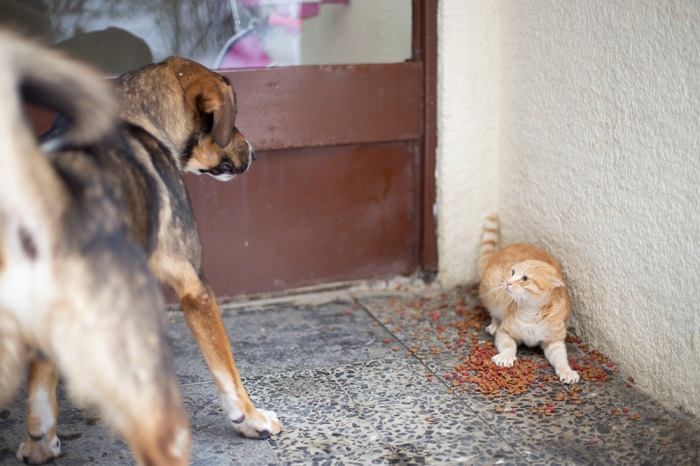
Environmental stressors may make your cat unwilling to eat. These stressors include eating too close to other pets or in busy parts of the home.
Stress, anxiety, and fear can alter a cat’s appetite, triggering anorexia or overeating.
Eating near other cats can lead to anxiety accompanied by a range of behavioural consequences, including inappetence due to fear of proximity to an incompatible or unfamiliar cat.
The introduction of new food by itself can cause stress, which should be negated in a tense environment where the individual may prefer food, they are used to rather than a new one.
Rehoming of cats with strong nutritional preferences can cause the cat to stop eating altogether. You can minimise the risk of inappetence upon adoption by offering the same food gradually in parallel with new diet transition.
Cats do not react well to stressful negative associations with other pets, not to mention noisy children in the home. Make sure the environment is filled with love, serenity, and safety, especially during mealtime. You can also minimise stress through pheromone therapy.
In situations where a cat is experiencing anxiety compounded by unsuccessful attempts to alter the negative emotional situation, the cat may fall into behavioural depression, necessitating veterinary examination.
Prevent development of excessive anxiety and other uncomfortable feelings by exposing kittens or cats to new people, noises, places in a calm manner. Use positive reinforcement like praise, toys, treats, and massage.
Promote wellbeing by giving your cat the opportunity to establish social bonds and make decisions about their environment. Provide mental stimulation by means of positive experiences with interactive toys, new exploratory objects, hidden food, visual inspiration, and scratching posts.
How Can I Stimulate My Cat’s Appetite?
Once you’ve taken your cat to the vet and determined the cause of your cat’s inappetence, you may have to take steps to stimulate their appetite. Here are a few ways to encourage your cat to eat.
Ensure that your cat’s food is served the way your cat wants it.
Cats are fastidious, enjoying their food and bowls a certain way. Inspire your cat to eat by washing their bowls in hot soapy water at least once a day, make sure no food is stuck to the sides as well as plates do not smell.
Make sure your cat’s food is palatable.
Increase food palatability by offering warmed nutrition plus food with high protein and/or fat content. Many cats are predisposed for certain food based on taste and odour combined with texture predetermined by previous negative likewise positive eating experiences.
Sometimes adding flavoured water such as tuna juice or chicken broth, hand feeding, or gentle stroking can benefit the cat.
Feed moist rather than semi-moist or dry food including foods with strong (especially meat, fish, or cheese) odours, offer small amounts of fresh food frequently then remove uneaten fresh food after 15-20 minutes.
Try dietary supplements.
- Supplementation of probiotics and prebiotics aids digestion, helps with improved immune function, and reduces diarrhea.
- Dietary omega-3 fatty acids used for chronic inflammatory conditions such as osteoarthritis, neoplasia, and cardiovascular disease have been studied for the potential effects of appetite improvement.
- Provision of B vitamins is simple and should be considered for inappetent cats. B12 vitamins are particularly good for boosting appetite. They can be administered orally or via injection.
- Appetite stimulants can be useful to increase food intake, though they can be unpredictable and rarely result in sufficient food intake in critically ill patients. Appetite stimulants are primarily reserved for use in recovering hospitalised patients, discharged patients, or palliative use.

Increase food palatability by offering warmed nutrition plus food with high protein and/or fat content.
Cat owners play a vital role in monitoring behaviours associated with loss of appetite together with psychological welfare.
A cat presenting with anorexia and fatigue may have an underlying medical problem or may simply be stressed by environmental changes.
A species-appropriate diet, positive experiences, and environmental enrichment all play a massive role in maintaining great physical health and emotional wellbeing in a cat.
-
Davies, J. (2016, April 25). Cat friendly hospitalisation made easy. International Cat Care. Retrieved July 14, 2020
-
Dorey-Philips, C. (n.d.). How to nurse the painful cat. UK: International Cat Care. Retrieved July 16, 2020
-
Heath, I. R. (2016). Feline Behavioral Health and Welfare. St Louis, MO: Elsevier. Retrieved July 15, 2020
-
Korman, R. (2015, January). Management of anorexia 2: feeding tubes. UK: International Cat Care. Retrieved July 28, 2019
-
P Jane Armstrong, K. L. (2010). Introduction to Feeding Normal Cats. In Small Animal Clinical Nutrition Book (p. 365 and 386). Mark Morris Institute. Retrieved July 14, 2020
-
Practitioners, A. A. (n.d.). Senior Care Brochure. (P. P. Plan, Compiler) USA. Retrieved July 15, 2019
-
Purina, N. (2018). Feline nutritional peculiarities in health and disease. (N. Purina, Compiler) United States. Retrieved July 02, 2019
-
Rachel Korman, W. A. (2014, October). Management of anorexia 1: nursing and appetite stimulation. UK: International Cat Care. Retrieved July 29, 2019
-
Rodan, J. P. (2018). Friends for Life Caring for your older cat. US. Retrieved July 16, 2020, from American Association of Feline Practitioners.
-
Sparkes, D. S. (2016). ISFM Guide to Feline Stress and Health; Managing negative emotions to improve feline health and wellbeing. Tisbury, Wiltshire, UK: International Cat Care. Retrieved July 17, 2020
-
Wilson, J. (2017, June 20). Loss of Appetite in Cats – Causes, Symptoms & Treatment. Retrieved 31 July, 2019, from cat-world: https://www.cat-world.com.au/anorexia-loss-of-appetite-in-cats.html
